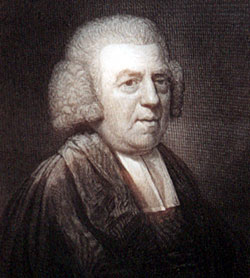|

John Newton, who converted to evangelical Christianity in 1748, led an adventure-filled life as a master of a slave ship. He wrote of his experiences in his autobiography 'An Authentic Narrative' published in 1764.
Following retirement from the sea, Newton became Surveyor of the Tides in Liverpool, during which time he studied Greek, Hebrew and Theology. He married Mary Catlett in 1750: they had no children. Newton was ordained as a priest in the Church of England in 1764.
Newton accepted the curacy of Olney, where he lived until 1780 when he became Rector of St Mary Woolnoth in London.
John Newton is perhaps best known as the author of the world-famous hymn, Amazing Grace, which was one of the Olney Hymns written in collaboration with William Cowper. He also wrote some important theological works.
Newton is also remembered for his work in the anti-slavery movement, which occupied part of his later life.
For a more detailed biography of Newton, click below. There will be four parts in due course, covering the whole of Newton's life. You can move through the different pages in order using the "Next" buttons on each page:
PART 1: Childhood and Life at Sea
|
